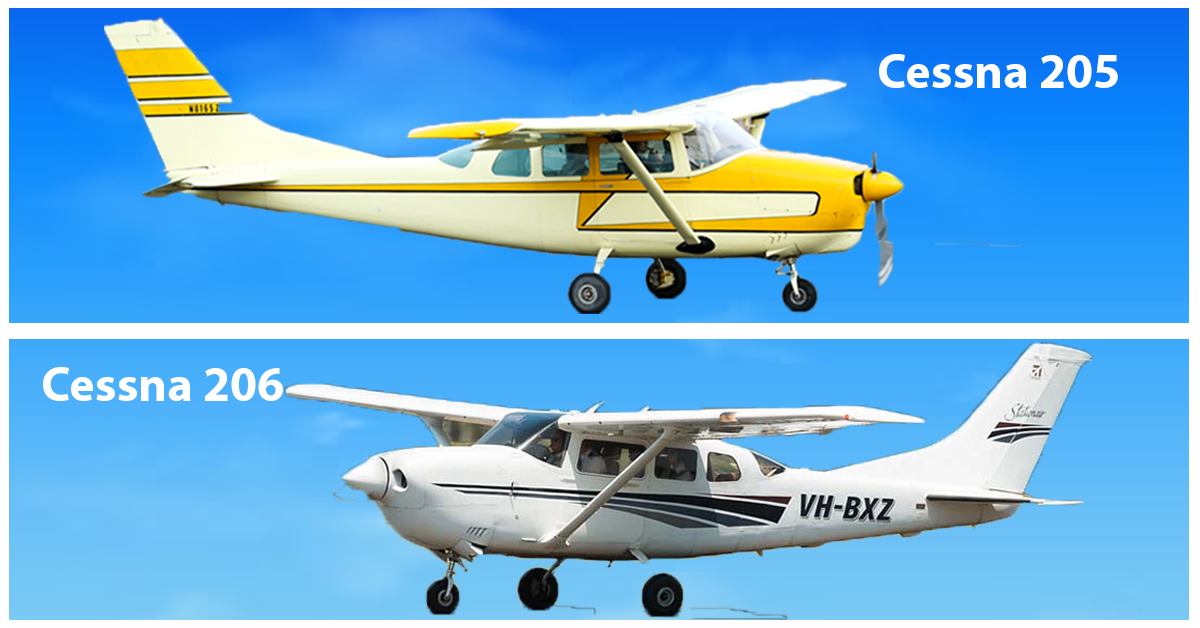In the world of general aviation, the Cessna 205 vs 206 stand out as two of the most iconic single-engine aircraft. While they share similarities, being part of the same family, there are notable differences that make each model unique. This article aims to provide an in-depth comparison of the Cessna 205 and 206, focusing on their design, performance, and operational capabilities to give pilots and aviation enthusiasts a clear understanding of what sets these two models apart.
Cessna 205 vs 206
In the comparison Cessna 205 vs 206, key differences lie in their design, performance, and utility. The Cessna 205, also known as the Super Skywagon, offers a dependable and straightforward flying experience, ideal for personal and light commercial use with its six-seat configuration and moderate payload capacity.

On the other hand, the Cessna 206, an evolved version of the 205, stands out with its enhanced engine power, greater payload capacity, and unique utility door on the pilot’s side, making it more suited for versatile commercial operations and challenging environments. While both aircraft share a high-wing design and a reputation for reliability, the 206’s improved capabilities position it as a more robust option for demanding flight conditions and diverse utility applications.
| Feature | Cessna 205 | Cessna 206 |
|---|---|---|
| Passenger Capacity | 6 | 6 |
| Engine Power | Lower compared to 206 | Higher |
| Cargo Door | Single door on co-pilot side | Utility door on pilot’s side |
| Performance | Good for short-haul flights | Enhanced for high altitude and rough terrain |
| Payload Capacity | Moderate | Higher |
| Primary Use | Personal and light commercial | Versatile utility and commercial |
Cessna 205

The Cessna 205, known for its reliability and spacious cabin, is a solid choice for personal and light commercial aviation. It offers seating for up to six passengers and is appreciated for its smooth flight characteristics. Ideal for short-haul flights and capable of operating from shorter runways, the 205 is a versatile aircraft perfect for pilots who value simplicity and effectiveness.
Cessna 206

The Cessna 206 stands out for its robust build, enhanced performance, and greater payload capacity. It’s equipped with a more powerful engine, making it suitable for high-altitude, hot and high conditions, and challenging terrains. The unique utility door facilitates easier loading, making it a go-to aircraft for commercial operators in need of a reliable and versatile utility aircraft.
Cessna 205 vs 206 Design and Build
The Cessna 205: The Cessna 205, also known as the Super Skywagon, was introduced in the 1960s. It’s a six-seat, high-wing, single-engine aircraft renowned for its reliability and versatility. The 205 offers a spacious cabin and is designed with a focus on passenger comfort and cargo flexibility. It features a single door on the co-pilot side, which is a distinctive aspect of its design.
The Cessna 206: The Cessna 206, also referred to as the Super Skywagon or Stationair, is a direct descendant of the 205. Introduced shortly after the 205, it presents several enhancements, including a more powerful engine and improved load-carrying capabilities. The 206 is known for its rugged build and versatility, capable of carrying up to six passengers. It features a unique utility door on the pilot’s side for easier loading of cargo and passengers.
Cessna 205 vs 206 Performance and Capabilities
The Cessna 205: With its powerful engine, the 205 offers solid performance, particularly valued in utility operations. It’s well-suited for short-haul flights and is capable of operating from shorter runways, which makes it ideal for accessing remote areas. The aircraft’s stable flight characteristics and ease of handling have made it a favorite among pilots for personal and commercial use.
The Cessna 206: The 206 takes the utility features of the 205 and enhances them. Its more powerful engine provides better performance, especially at higher altitudes and in hot and high conditions. The 206’s ability to handle rough terrain and short airstrips, combined with its increased payload capacity, makes it a preferred choice for cargo and passenger operations in challenging environments.
Conclusion
In summary, while the Cessna 205 and 206 share the same lineage, they cater to different needs within the general aviation community. The 205 is an excellent choice for personal use or light commercial operations, offering comfort and reliable performance. The 206, on the other hand, is a powerhouse of utility and versatility, making it ideal for more demanding commercial operations, especially in challenging environments. Both models continue to be celebrated for their durability, reliability, and contribution to the world of aviation.
FAQs
What are the main differences between the Cessna 205 and 206?
Which aircraft is better for high-altitude flights?
Which model offers more in terms of payload capacity?
Can both aircraft be used for commercial operations?
Are there significant differences in handling between the two models?



